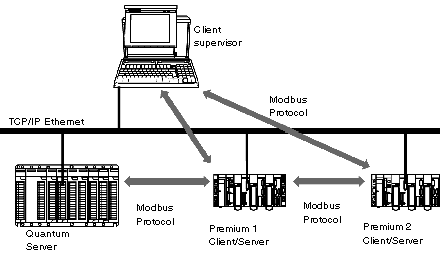Modbus on TCP/IP enables communication to be established through the Modbus protocol between a Premium PLC and a Quantum PLC or another Premium PLC and supervisor software on a PC or other device complying with the Modbus protocol.
The same module can communicate with a remote device in client mode (for example a Quantum PLC) and another remote device in server mode (for example a supervisor PC).
In the above figure, Premium PLC 1 is the client to the Quantum PLC. It opens the TCP/IP connection and sends Modbus messages to the Quantum.
Premium PLC 2 is the server to the supervisor. The supervisor has opened a TCP/IP connection for sending Modbus messages to Premium 2.
A UNI-TE and Modbus double profile is not supported on the same Premium remote station. In other words, station A, at a given moment, can not have both Modbus communication and Uni-TE communication toward station B.
TSX ETY 100 Considerations
The client/server modes are exclusive to a given remote device in order to improve communication performance. PLC applications and network architectures must be designed so that switching from one mode to another between the same two devices is as rare as possible.
NOTE: Frequent mode switching could result in lost messages:
-
If the Premium PLC communicates in server mode with a Quantum PLC that has opened the TCP/IP connection, the issuing of a message by the client Control Expert application will cause the server TCP/IP connection to close down after any server transactions in progress have been processed.
-
f the Premium PLC that has opened the TCP/IP connection communicates in client mode with a Quantum PLC, a request to open the connection from the Quantum will cause the client TCP/IP connection to close down with the possible loss of any client transactions in progress.
